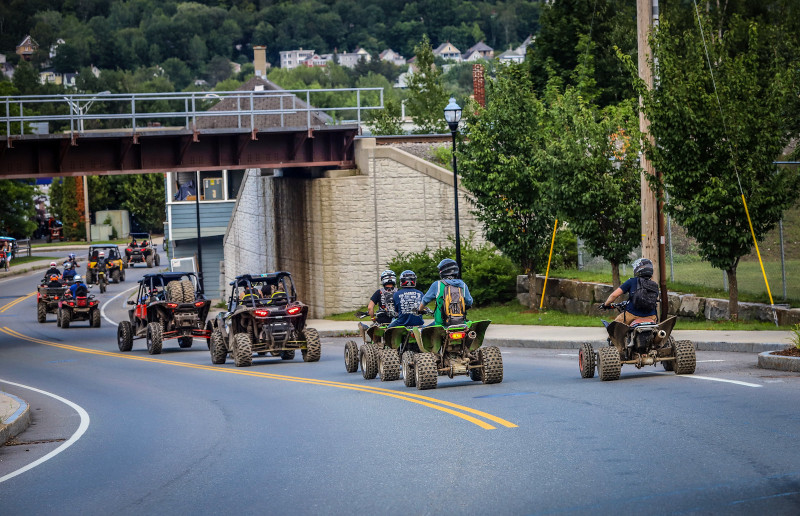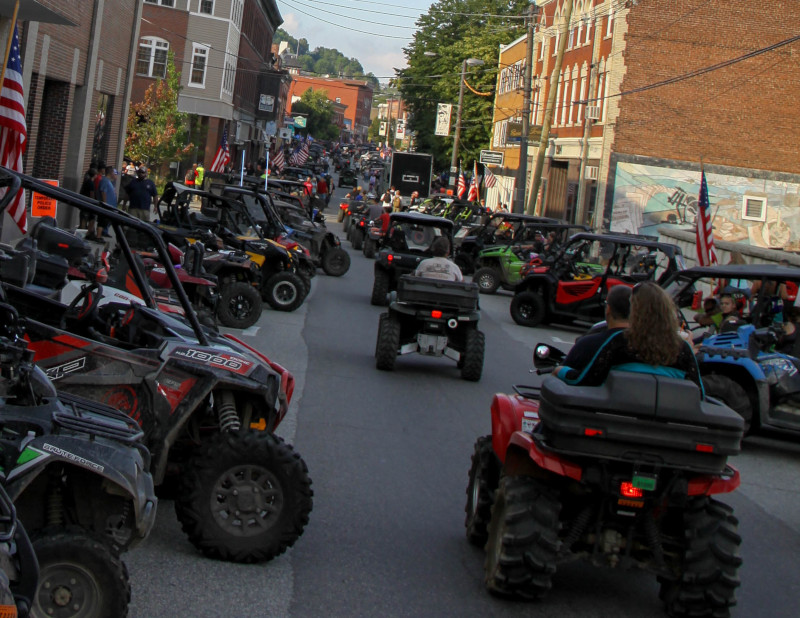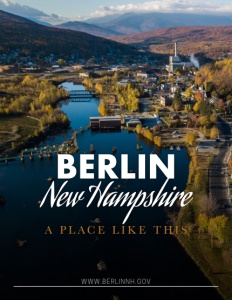Berlin, New Hampshire
A place like this
Business View Magazine interviews representatives of Berlin, NH, as part of our focus on the economic resiliency of American cities.
Deep in New Hampshire’s Great North Woods Region, along the banks of the Androscoggin River and in the shadow of Mt. Washington – at 6,288 feet, the highest peak in the Northeastern United States – lies the small city of Berlin, the northernmost metropolis in the Granite State. Incorporated in 1829, with 65 inhabitants, Berlin’s first industry was farming. Since that time, the City’s progress has always depended on its natural resources. By the early 1800s, the community had already developed into a center for logging and related forest industries. Abundant lumber from the North Woods was floated down the Androscoggin River, whose falls then provided water power for the sawmills and later, paper mills. The St. Lawrence & Atlantic Railroad came to Berlin in 1851, and the Boston and Maine Railway followed in 1874, further extending the City’s economic reach, and the lumber and paper industries thrived through the mid-20th century. With the ability to ship goods by rail this spurred the City into becoming a center of research and innovation for the paper industry.
Today, those early days are just a memory. Although there is still some paper manufacturing in the area, notably by Gorham Paper and Tissue, located nearby in the town of Gorham, most of the paper mills have shut their doors. “The City is not unlike a lot of other communities in the country that had a base of manufacturing – in our case, it was paper – that has come and gone,” says City Manager, Jim Wheeler. “We have been seeking to redefine ourselves and replace the economy that we lost when the paper mills left.” In that redefinition process, Berlin has carved out some interesting and innovative niches in the modern marketplace, all of which still rely on the natural resources which are so plentiful in the 1,830 square miles of Coos County.

“One of the components is our effort in renewable energy,” Wheeler begins. “We have several large producers in the City. We have four hydro-electric facilities that generate about 30 MW of power. We have a new, 75 MW biomass facility, and what is great about that facility is that the wood basket that used to feed the paper mill is now feeding the biomass facility. We have a tremendous amount of forest land here. It was once a resource for the paper industry and now is a resource for the renewable energy biomass industry. We also have five wind towers in Berlin that generate about 14.25 MWs. All told, we’re looking at about 118 MWs of renewable energy being generated in the City. We generate more power in our City than is consumed by the entire county so it goes back to the grid, making us a major exporter of renewable energy.”
Another area of development in Berlin has been OHRV (Off-Highway Recreational Vehicle) tourism. “Our former mayor, Bob Danderson (2000-08) came up with the idea of an OHRV park in the City,” Wheeler recounts. “Ultimately, the City was able to work with the State of New Hampshire Bureau of Trails, Division of Recreation. The state acquired a parcel of land that the City owned, known as Jericho Lake, a beautiful woodland and lake area that currently hosts about 70 miles of OHRV trails with plans to build out to 300 miles. They have some campground facilities and that has just grown and grown, year after year.”
In fact, the City has capitalized on the concept with its ATV (All-Terrain Vehicle) Festival, which it has held for the past ten years. “In the middle of the summer, we have a three day festival,” Wheeler notes. “We bring in six or seven thousand people and their OHRVs.” Berlin’s own festival was so successful that it attracted the Polaris Corporation, a large manufacturer of snowmobiles and ATVs, which held its own celebration which they’ve dubbed RZR Fest, held for two consecutive years, an event which brought in another six or seven thousand people,” Wheeler adds.
In addition, Coos County has an initiative called “Ride the Wilds.” It’s the northeast’s largest interconnected ATV trail system, with more than a thousand miles of trails carved through the rugged North Woods terrain. No public funds were used to create Ride the Wilds; it’s been bankrolled by a collection of not-for-profit riding clubs whose members work to construct, maintain, and patrol the trails.
Over the years, the OHRV boom has even led to the opening of all of Berlin’s streets for these off-road vehicles. “We started out slowly by opening up the streets during one of the ATV Festivals,” Wheeler explains. “Ultimately, we opened up all our streets and it’s been wildly successful with large benefits. We have people who love to OHRV, who have bought second homes here. We had a housing market that was soft and people had pulled up stakes because the paper industry had left the area. We had a surplus of housing and the market is now beginning to shift and property values have increased over the last year substantially. This has been a great benefit to local economy over the last few years.
Another tourist draw in Berlin is called “RiverFire,” an annual event occurring on the Androscoggin River for the past decade. “It’s really quite a spectacle,” says Wheeler. “In the river, there are these boom piers, which are little islands that were created during the old river driving days, when the paper companies used to drive logs down the river.” The boom piers actually served as traffic cones, dividing the river into lanes so that the lumber companies could better control their log rolls, downstream. They were little islands of rock, framed by hemlock logs. Generally about ten feet wide, they were spaced a few hundred feet apart, depending on the depth of the river, stretching north from Berlin for eight miles. “We build bonfires out on top of these boom piers. We draw six or seven thousand people during that event.” RiverFire is a hallmark event for us and it is just one of several events that are led by the Androscoggin Valley Chamber of Commerce. We are so fortunate to have this group of people who seem to have boundless energy for economic development in the region.
Yet another development project in Berlin is the reinvention of the famous Nansen Ski Jump, otherwise known as “Big Nansen” and “The Sleeping Giant.” Originally constructed in 1937, Big Nansen was, at the time, the largest steel-towered ski jump in the world. “It held the first ever Olympic tryouts in 1938 and was a significant venue for decades,” says Wheeler. The jump closed for good in 1988, and started to fall into disrepair. Then, in 2015, the State of New Hampshire, which had taken over ownership of the jump, began to restore it mostly as a visitor site and a place for photo opportunities.
“The original intent was to have it serve as a historical icon; there was no intent to actually have it become an active jump, again,” Wheeler avers. “But then there was this opportunity to have this Olympic jumper, named Sarah Hendrickson, sponsored by Red Bull, to come and jump in 2017. So, Sarah came and jumped; it was a very successful event and it generated a lot of interest in reactivating the jump.”
We are lucky to have a dedicated community group called the Friends of Big Nansen, which has led the jump’s redevelopment and plans to re-open the jump to competitive ski jumping by 2020. Friends is a committee of the Nansen Ski Club, the oldest continuously-operating skiing club in North America, founded in 1872 in Berlin by Norwegian immigrants.
Meanwhile, Berlin has its own plans and agendas for upping the quality of life for its citizens and guests. “A couple of years ago, the City undertook the rehabilitation of a significant portion of Route 16 in the heart of the City,” Wheeler reports. “We reconstructed it with streetscaping, more efficient street lighting, and trees; we made it much more user-friendly for pedestrians. This section of Route 16 travels alongside the Androscoggin River. In particular, the City owns a 3,500-foot section is adjacent to the river. Further plans for this area include a river walk which we are scheduled to construct next summer. The river walk is going to be in the same area as RiverFire and we’re hoping that this addition will enhance that event to make it even more successful.”
Another interesting initiative within Berlin’s economic development agenda is a municipal snow melt project. “We are partnering with Burgess BioPower, the operator of the biomass facility in town on this project,” Wheeler remarks. “Their facility sits very close to our downtown, so we came up with this idea based on the fact that these power facilities generate a tremendous amount of excess heat, which is available for beneficial use. We were inspired by the community of Holland, Michigan, which is very similarly situated like the city of Berlin; it has an annual snowfall of about 70 inches a year. Back in the 1980s, Holland captured the excess heat from their power generating facility and created a snow melt system in their downtown. So, we’ve been working with Holland and an outside consultant and we’ve completed a feasibility study, we now know what it will take to make it possible.”

“We want to build a snow melt system as a tool to help revitalize our downtown,” Wheeler continues, “in winter time, we get a significant amount of snow on the ground. Typically, we have six months of snow. We like the snow for winter sports; we’re surrounded by ski areas; we have snowmobiling, hopefully soon, ski jumping, and that’s all good, but when you want economic activity in your downtown, snow can be a deterrent. When we’ve spoken with Holland, they have told us that they’ve done nothing but expanded their snow melt system since the 1980s. The project has been a big economic driver for their community. Before they built it, they had a high vacancy rate in their downtown and since they built it, they have almost a zero vacancy rate. We have some empty buildings downtown and we would love to see a similar impact in our downtown that Holland has seen in their downtown. We believe it’s going to have a big effect on economic activity in the downtown.”
Wheeler admits that Berlin will need some grant money for the system’s capital costs, and is looking at several potential sources of funding. “The best fitting program is called BUILD (Better Utilizing Investments to Leverage Development) – it’s a Federal Highway Administration grant program,” he explains. “It’s got to be transportation-related, which this is; it’s got to stimulate economic activity, which it will; and it needs to be innovative, which it is. The program is focused on rural areas and most communities in New Hampshire are considered rural areas. We are waiting for the next round of funding to be announced, it will be a long process but we are very excited about this project.”
“The City Council saw the value in the Rte. 16 upgrade project and the river walk and have made the resources available to complete these important projects,” Wheeler adds. “They are also firmly behind the downtown reconstruction project which will include the snow melt system. We couldn’t ask for a more progressive City Council who has the community’s growth and well-being close at heart.”
Pamela Laflamme, Berlin’s Community Development Director, believes that, going forward, it’s time for the City to adopt a more all-inclusive development and marketing strategy. “In the last two or three decades, the City has had many projects, but nothing comprehensive in terms of strategy,” she states. “We have an Economic Development Board, which goes by the acronym: BIDPA, the Berlin Industrial Development & Park Authority, because its original charge, when it was created in the 1970’s, was overseeing industrial growth, specifically in our industrial park. As the years have gone on, BIDPA has taken the charge for economic development for the whole City.
“BIDPA has been looking at different areas of the City and getting input from local businesses, and they decided late last year that they wanted to hire a consultant that was familiar with small, rural economies like our own and to take a look at trends and make recommendations on what might be a good fit for our area. We want them to use data to support their ideas that could make sense for our community. This is a big undertaking for the City. We just hired a consultant and they will start work by holding a community forum. At the end of the process we are hoping to implement the strategies that are recommended that make the most sense for Berlin. Parallel to that, we’re getting ready to update our community Master Plan. There’s a lot going on in the Berlin around community and economic development. There are many people who are doing a deep dive into figuring out our new path forward in terms of what our economy will look like.”
What seems most certain is that as it has done in the past, Berlin’s next economy will continue to make the most out of the City’s location, and the surrounding bounties of Mother Nature. “Berlin is a unique place,” says Wheeler. “It’s two-and-a-half hours from Boston; two-and-a-half to three hours from Montreal; a couple of hours to the seacoast, and we’re situated right adjacent to the Presidential Range in the White Mountains – Mt. Washington, Mt. Jefferson, Mt. Adams. We live in a beautiful landscape. While Berlin is remote, the community offers so much in terms of the quality of life for the person who likes the outdoors, winter and all the activities that happen during the season. This is what we’re working to leverage, to attract those kinds of people who want to live, work and recreate in a place just like this.”
AT A GLANCE
WHO: Berlin, New Hampshire
WHAT: A city of 10,000
WHERE: The northernmost metropolis in the Granite State
WEBSITE: www.berlinnh.gov




